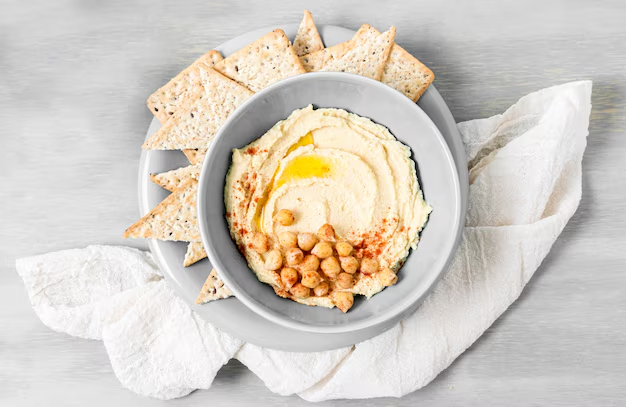Hummus is a creamy, flavorful dip loved by many worldwide. But when it comes to its nutritional profile, an important question arises: does hummus have carbs? This question matters particularly for individuals monitoring their carb intake due to dietary preferences or health reasons.
Hummus, a Middle Eastern staple, has become a global favorite due to its versatility and rich taste. It’s commonly used in Mediterranean diets and pairs well with vegetables, bread, and crackers. For health-conscious individuals or those following specific diets like low-carb or ketogenic plans, understanding the nutritional makeup of hummus is crucial. Let’s explore whether hummus fits into these dietary goals and how it compares nutritionally.
Nutritional Composition of Hummus
A. Macronutrient Breakdown
1. Carbohydrates
Hummus contains carbohydrates primarily derived from chickpeas, its main ingredient. On average, a 2-tablespoon serving of store-bought hummus contains about 4 to 6 grams of carbs. Homemade versions may vary slightly based on ingredients, but the difference is minimal.
2. Proteins
Hummus provides a decent amount of plant-based protein, with approximately 2 grams of protein per serving. This makes it an excellent choice for vegetarians or anyone looking to increase their protein intake from non-meat sources.
3. Fats
Hummus is rich in healthy fats, primarily due to the use of tahini and olive oil. These fats are mostly unsaturated, contributing to cardiovascular health. A serving typically contains 3 to 5 grams of fat, making it a filling yet healthy option.
B. Micronutrient Content
Hummus is not just about macronutrients; it’s also packed with essential vitamins and minerals. It’s a good source of iron, magnesium, phosphorus, zinc, and B vitamins. These nutrients play critical roles in energy production, bone health, and immune function. Additionally, the sesame seeds in tahini provide calcium and antioxidants.
Carbohydrate Content in Hummus
A. Detailed Carbohydrate Analysis
Hummus contains total carbs and net carbs, which can differ significantly due to its high fiber content. Dietary fiber is non-digestible and doesn’t spike blood sugar levels. For instance, a serving of hummus with 6 grams of total carbs may have 2 grams of fiber, reducing the net carbs to 4 grams. This makes hummus a manageable option for those watching their carb intake.
B. Serving Size Considerations
A typical serving size of hummus is about 2 tablespoons (30 grams). In this portion, the carb count is relatively low, but larger servings can add up quickly. For those aiming to stay within a strict carb limit, portion control is vital. Visualizing servings—like 2 tablespoons compared to a cup—can help maintain dietary goals.
C. Comparison with Other Dips and Spreads
How does hummus stack up against other dips? Here’s a quick comparison:
| Dip/Spread | Carbs (per 2 tbsp) |
| Hummus | 4-6 grams |
| Guacamole | 2-3 grams |
| Baba Ganoush | 3-4 grams |
| Spinach Artichoke Dip | 2-5 grams |
Hummus is slightly higher in carbs than guacamole but similar to baba ganoush. However, its fiber and nutrient content make it a nutritious choice.
Hummus in Low-Carb and Ketogenic Diets
A. Suitability of Hummus for Low-Carb Diets
Hummus can fit into a low-carb diet when consumed in moderation. Its carb count is manageable, especially if paired with low-carb dippers like celery or bell peppers. Sticking to 2 tablespoons per serving can keep carbs in check while providing plenty of flavor.
B. Hummus and the Ketogenic Diet
The ketogenic diet, which demands very low carb intake, poses more challenges for hummus lovers. While hummus isn’t strictly keto due to its chickpea base, small portions may still work for those on a flexible keto plan. A 1-tablespoon serving can be a better choice for keto dieters to stay within their carb limit.
C. Low-Carb Alternatives to Traditional Hummus
For stricter low-carb or keto diets, alternatives to traditional hummus can be explored:
- Zucchini Hummus – Made with zucchini instead of chickpeas, this variation is lower in carbs but equally creamy.
- Cauliflower Hummus – Cauliflower serves as a low-carb base while retaining a similar texture.
- Avocado Hummus – Combines avocado and tahini for a creamy, low-carb spread.
Health Benefits of Hummus
Hummus offers many health benefits as mentioned below:

A. Rich Source of Plant-Based Protein
Hummus supports muscle maintenance and overall health through its plant-based protein. This is particularly beneficial for vegetarians and vegans.
B. High Fiber Content and Digestive Health
The fiber in hummus aids digestion and promotes satiety, helping you feel full longer. It’s a great way to maintain gut health naturally.
C. Healthy Fats and Heart Health
The unsaturated fats in hummus contribute to improved heart health by reducing bad cholesterol (LDL) levels and boosting good cholesterol (HDL). Regular consumption can support a healthier cardiovascular system.
D. Low Glycemic Index and Blood Sugar Regulation
Hummus has a low glycemic index (GI), meaning it doesn’t cause significant blood sugar spikes. This makes it suitable for people with diabetes or those aiming to manage their blood sugar levels.
Potential Considerations When Consuming Hummus
Hummus is a delicious and nutritious food, but it’s essential to consider a few factors when adding it to your diet. These include calorie density, sodium levels, and potential allergens. Understanding these considerations can help you enjoy hummus while staying mindful of your health.
A. Calorie Density and Weight Management
Hummus is nutrient-dense but also calorie-dense, which means it packs a lot of calories in a small serving. While it’s a healthy option, overeating can hinder weight management goals.
- Calorie Awareness
A standard serving of hummus, about 2 tablespoons, contains around 70 to 80 calories. This might not seem like much, but larger portions can quickly add up, especially when paired with high-calorie dippers like bread or chips. - Portion Control
For individuals watching their weight, sticking to recommended serving sizes is key. Using hummus with low-calorie vegetables, such as celery or cucumbers, can help balance calorie intake without sacrificing volume or satisfaction. - Making Hummus Lighter
Homemade hummus allows you to control the ingredients, such as using less olive oil or tahini, reducing the overall calorie content while maintaining its creamy texture.
B. Sodium Content in Store-Bought Varieties
Store-bought hummus often contains added sodium, which can be a concern for individuals monitoring their salt intake. Excessive sodium can contribute to high blood pressure and water retention.
- Understanding Sodium Levels
A 2-tablespoon serving of store-bought hummus typically contains 150 to 200 milligrams of sodium. While this is manageable for most people, larger portions or frequent consumption can lead to higher sodium intake. - Reading Labels
Always check the nutrition label to identify the sodium content per serving. Opt for brands labeled as “low sodium” or “no added salt” to reduce sodium intake. - Low-Sodium Alternatives
Making hummus at home gives you complete control over the amount of salt added. Experimenting with herbs, spices, and lemon juice can enhance flavor without the need for additional sodium.
C. Allergens and Dietary Restrictions
Hummus is generally safe for most people, but some ingredients may pose challenges for individuals with allergies or dietary restrictions.
- Common Allergens in Hummus
The primary allergen in hummus is sesame, found in tahini. Sesame allergies are relatively common and can cause mild to severe reactions in susceptible individuals. Some store-bought varieties may also contain nuts or traces of other allergens. - Allergy-Friendly Options
For those with sesame allergies, alternative recipes using sunflower seed butter or almond butter in place of tahini are a great solution. These modifications allow you to enjoy a similar flavor and texture. - Dietary Accommodations
Hummus is naturally vegan and gluten-free, making it suitable for many dietary preferences. However, it’s essential to verify ingredient lists in store-bought options to avoid cross-contamination or hidden additives.
Incorporating Hummus into a Balanced Diet

Hummus can be a versatile addition to a balanced diet. From creative serving ideas to making your own versions at home, there are plenty of ways to enjoy hummus healthfully.
A. Creative Serving Suggestions
Adding hummus to your meals doesn’t have to be boring. Pairing it with low-carb vegetables or using it in unique ways can elevate your dishes.
- Vegetable Pairings
Low-carb vegetables like celery, cucumbers, bell peppers, and zucchini slices are excellent dippers. They add crunch and nutrition without contributing many carbs or calories. - As a Spread
Hummus makes a great substitute for mayonnaise or butter on sandwiches and wraps. Use it as a flavorful base for wraps filled with lean proteins, greens, and fresh veggies. - Meal Additions
Add a dollop of hummus to grilled chicken, roasted vegetables, or even baked potatoes for extra flavor and nutrition. It can also serve as a creamy salad dressing when mixed with a bit of water or lemon juice.
B. Homemade Hummus Recipes
Making hummus at home is easy and allows for complete control over ingredients and flavors. Plus, it’s often more economical than store-bought options.
- Basic Hummus Recipe
- Ingredients: 1 can (15 oz) chickpeas, 2 tablespoons tahini, 1 garlic clove, juice of 1 lemon, 2 tablespoons olive oil, salt, and water (as needed).
- Instructions: Blend all ingredients in a food processor until smooth. Adjust the consistency with water, and season to taste.
- Flavor Variations
- Spicy Hummus: Add a dash of cayenne pepper or a roasted red chili.
- Herb Hummus: Blend in fresh parsley, cilantro, or dill.
- Garlic Lovers’ Hummus: Double the garlic for an intense flavor.
- Low-Carb Alternatives
Use cauliflower or zucchini instead of chickpeas to create a low-carb hummus that’s just as creamy and delicious.
Conclusion
Hummus contains moderate amounts of carbs, making it a versatile choice for various diets. A standard serving provides around 5–6 grams of total carbs, with net carbs being lower due to its fiber content.
Whether you’re on a low-carb diet, following a vegan lifestyle, or simply looking for a nutritious snack, hummus fits the bill. With mindful portion control and a creative approach, it can be a delightful addition to your meals.
Frequently Asked Questions (FAQs)
A. Does hummus have carbs?
Yes, hummus contains carbohydrates. A 2-tablespoon serving provides approximately 5–6 grams of total carbs. Its fiber content reduces the net carbs, making it suitable for many dietary preferences.
B. Is hummus suitable for a keto diet?
Hummus can be included in small amounts on a keto diet. Portion control is essential to stay within daily carb limits.
C. What are some low-carb alternatives to hummus?
Low-carb options include baba ganoush (made from eggplant) and cauliflower hummus, both of which offer fewer net carbs while retaining creamy textures.
D. How can I reduce the carb content in homemade hummus?
Swap chickpeas with low-carb alternatives like cauliflower, zucchini, or even avocado for a creamy, keto-friendly version.
E. What is the glycemic index of hummus?
Hummus has a low glycemic index, making it a good choice for maintaining steady blood sugar levels, especially for diabetics.

